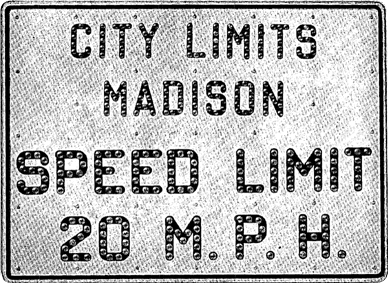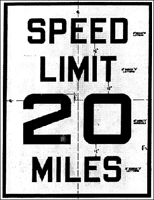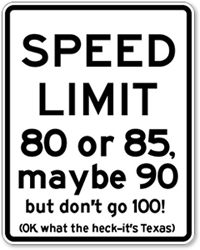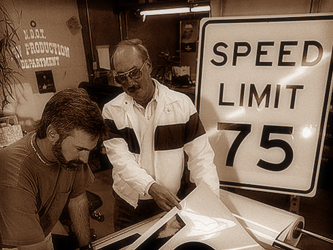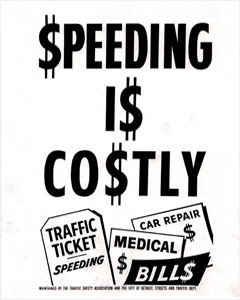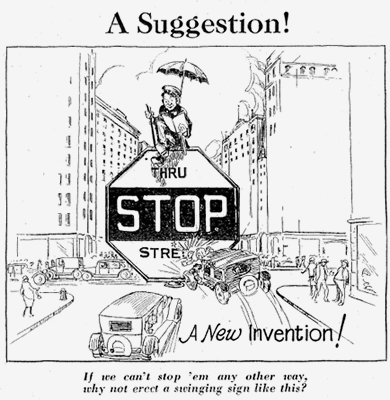Early Speed Limit Signs
As cars have become faster, speed limit signs have naturally kept up. The first speed limit signs were posted at city and town limits. Early signs were not reflective. By the middle to late 20’s however, many cities required that speed limit signs be illuminated. The early requirement was for a famous GE style of light, called a “MAZDA” lamp. The New York State legislature, in 1925, passed a law that "each city shall have placed conspicuously [signs on] each main highway, where the rate of speed changes [and signs shall be] adequately illuminated between sunset and sunrise".
For many townships and cities, however, internal illumination proved difficult. Too many roads needed speed limit signs and power was not readily available. As a result, speed limit signs started to use “cats eye” reflectors. Signs with reflectors captured the light from early auto headlights and reflected the message back to the driver.
Arrow sign is used to designate a road near a schoolhouse and limits speeds to 10 MPH. The arrows are from July, 1925 American City Magazine, "Traffic Regulation and Directions", which showed recommendations from the International Police Conference.
Different cities were free to enact different speed limits. This sign is shown from the Lyle Sign Catalog of 1925. Note the use of cats eye reflectors.
By the late 1920’s however, the interstate system adopted signs which initiated many of the design elements that we see today on our current Speed Limit sign designs. The signs were rectangular, taller than wide, printed in black and white and highlighted the actual numerical speed limit in taller letters. Rectangular signs “are used to carry direction of use or benefit to the driver” (1927 AASHO). AASHO also cited that the dimensions of Speed Limit signs (a tall rectangle) distinguish them from other directional signs.
Photo of a speed limit sign from the 1930’s (in author’s collection).
Speed Limit Sign adapted by the Joint Board of Interstate Highways, as reported by the American City Magazine, 1925. The middle sign shows the AASHO R4 Sign from 1927.
But, most early roads were not part of the nascent interstate system, nor were they part of a city’s street network. These early roads, which still transverse rural communities, seldom posted signs. For many, the “honor system” was predominant.
Vintage Speed Limit Sign from Redditpics.
By the late 20’s and 30’s, speed patrols become more common (Photo from the Author’s Collection).
The debate between those demanding the freedom to travel at high speeds in an unregulated environment and others citing the need for greater security and increased regulation (e.g. signs) was common in the 20’s and 30’s. For certain communities, "too slow speeds” were also an issue. As reported in the June, 1925 Lyle Sign Post, the chairman of the Maryland State Roads Commission, John Mackall, "advises substitution of the maximum speed limit with a minimum speed limit, to speed up traffic. Mackall also suggested slow-moving vehicles be barred from main streets during peak hours".
Many states did not require drivers licenses. As part of the author’s own family lore, there is a wonderful story of two strong-willed daughters, Lydia and Mary, traveling from their home in North Dakota to visit their father, Senator Langer, in Washington, DC. With little experience, other than on farm machinery and certainly no license, they ended up in Washington in record time. Speed limits (and the few Speed Limit Signs) were proudly ignored.
For more discussion, see the excerpt below on fixed speed limits: "
Should there be Fixed Speed Limits?". Even in the 30’s and 40’s, speed limits were not uniform. Should speed limits change, depending upon the weather conditions, road conditions and time of day (for example, during school hours)?
1959 (Author’s Collection).
A speed limit sign in Washington from 1975 that includes a metric limit and warns drivers that it is radar enforced (Photo in Author’s collection).
It was not uncommon to find that speed limit regulations changed from jurisdiction to jurisdiction. Towns often found themselves at odds with neighboring communities. Moreover enforcement was also inconsistent. See the 1927
excerpt below from one Mayor’s reported leniency towards speeders. In spite of this speed limit variability, school zones and pedestrian areas have always been more tightly regulated.
Modern Speed Limit Signs
The 1930 NCSH and 1935 MUTCD manuals defined the Speed Limit signs with most modern elements. The first mention of the yellow "advisory speed limit sign" occurred in the 1935 MUTCD. And in 1948, the MUTCD specification specified, essentially, all elements of the
current speed limit sign. The code R-2 and R-102 were defined in 1948 for the two sizes and colors of Speed Limit Signs.
From 1930 NCSH Urban Manual. This 24” x 30” sign uses three different fonts.
The modern speed limit sign (at right) was largely established and specified in the 1948 MUTCD. Yellow advisory speed limit signs were also defined in the 1948 manual.
Some excerpts on the changing specifications for the speed limit signs are as follows:
1930 NCSH Urban Manual. Sign size and font defined 30" x 24" [sign and the words] Speed Limit shall be in 3 1/2 inch Series E letters, the numerals shall be in 8" Series F letters and word "Miles" entry in 3" Series D letters.
1935 MUTCD (Signs Placed Where Speeds Change). Speed limit signs shall be erected on main thoroughfares at entrances to business or residential districts in municipalities and at other points were established prima facie limits are changed. It should be noted that the speed limits indicated in uniform vehicle code are prima facie limits. Therefore, where the code is in effect speed limit signs will indicate the maximum presumptively proper speed under normal conditions. It is frequently desirable to erect confirmatory speed limit signs at selected points within speed zones.
1948 MUTCD (Yellow Advisory Speed Limit Sign Defined). The advisory speed sign is a small plate, 13" x 30" square with a message [xx] mph in black on a yellow background. It may be used in conjunction with any standard yellow warning signs to indicate the maximum safe speed around a curve or through a hazardous location.
Another sidelight to the inevitable march towards state, county and local governmental standardization of speed limit signs was the desire to bring the metric system to the US. The FHWA received a crushingly negative response to this conversion and it was dropped in 1994.
The "Cat and Mouse Game" – the Police Radar Gun vs the Speeders
Law enforcement officials attempt to deter dangerous speeding by handing out tickets to speed limit violators. This type of regulation was not so easy in the beginning. Police officers had to be sure that violating vehicles were travelling well above the legal speed limit before they could pull these miscreants over and slap them with a ticket. Before the use of radar, such certainty was virtually impossible. Then, much to the chagrin of speedsters, came the invention of the radar gun.
Police officers using a clunky radar gun to catch speeding drivers in Chicago in 1956 (Photo in author's collection).
Created by Bryce K. Brown of Decatur Electronics, the first radar guns calculated the speed of objects by measuring the change in frequency of waves hiting moving objects due to the Doppler Effect. In April 1954, the first speeding ticket using the new radar device was issued by patrolman Leonard Baldy in Chicago, Illinois. Since its invention in 1954, radar speed gun have been used by police officers to measure the speeds of passing cars, and catch drivers who violate the lawful limit.
Leonard Baldy, the first police officer to use a radar gun to issue a speeding ticket, on the job with his radar gun in Chicago in 1954 (Photo in author's collection).
Two officers issue a ticket to a Chicagoan who was caught driving 36 mph in 25 mph zone by a radar gun in 1954. This was described as the first speeding ticket resulting from radar enforcement (Photo in author's collection).
Radar guns quickly expanded their electromagnetic reach from Chicago to the rest of the country, becoming a fixture of many American police forces. The first radar gun was large and unwieldy, and it looked somewhat like a telephone. Newer models were handheld and more easily transportable.
As they do, law-breakers eventually found a work-around – in this case, the Fuzzbuster. Invented in the 1970’s, the Fuzzbuster could detect police radar, and warn drivers to slow down when approaching a speed trap. In response to devices like the Fuzzbuster, police officers now use the more modern LIDAR speed gun, which uses laser waves instead of radar light waves. Radar guns and devices like them ushered in a new era of speeding tickets, in which American drivers, by choice or by law, grew more and more alert to speed limits, as posted on signs along the road.
The Need for Speed
Did you know that until 2010 there was a highway from Abu Dhabi to Dubai with a posted speed limit of 99 miles per hour?
The speed limit in opulent Abu Dhabi was
lowered to 87 miles per hour this year, but there are still plenty of roads in the country that do not regulate driving speeds. In contrast, in the United States, the fastest any driver is legally allowed to drive is now 85 mph; this limit is for rural roads in Texas, where apparently everything really is bigger, even the speed limits.
Speeding is the most frequently cited aggressive driving violation, so it’s no surprise that speed limit signs aimed at slowing drivers and reducing accidents heavily adorn almost every American road. Speeding is still a major public safety concern, but new technologies have made it easier for the police to deter speeding by issuing ticket to those who violate the speed limit.
First instituted in 1901, speed limits are assigned to increase road safety and reduce the risk of traffic collisions. For a long period, individual states were responsible for determining their own speed limit laws. After oil shortages in the 1970s, Congress established a national maximum speed limit of 55 mph. New, federal mandate for speed limits was signed into law by President Richard Nixon, and adopted by every U.S. state in 1974. Congress bumped the national limit by 10 mph in 1987, but repealed the law less than ten years later, returning speed limit responsibility to the states in 1995. Since then,
34 states have raised speed limits to 70 mph or above on some part of their roadway systems.
With the expansion of road systems in the first half of the 20th century, speed limits – and speed limit signs – had already grown vitally important to the safety of American citizens. By the 1940s, manufacturers were experimenting with different designs for speed limit signs.
By the time Carter and Nixon nationalized the speed limit, however, speed limit sign design was pretty much nationalized. The standardized black and white design was, at this point, the predominant standard for most jurisdiction. What was less clear was how to ensure that speed limit signs were visible to vehicles at night. According to a 1925 article by T.P. Brown in The Sign Post, most cities and towns used flood-light projectors or reflectors equipped with lamps to illuminate signs and promote nighttime road safety (Author Archives: The Sign Post: Number V, June 1925). Nowadays,
speed limit signs are made with different grades of highly reflective aluminum—from engineer grade to high-intensity grade to diamond grade as the most reflective—so that any driver properly using his/her car’s headlights would be able to see them at any and every hour of the night.
It’s been over 100 years since the introduction of automobiles. As cars have become faster and roads safer, speed limit signs have changed in parallel. Historically, car travel meant freedom - you traveled where and how fast your thought safe. With time, however, speed limit regulations became ever more complex, precise and law bound. Speed limit signs follow the same trends with changeable speeds depending upon pavement conditions, whether school is letting out and the kind of truck or car you are driving. Rules, politics and enforcement are all more complex than before. Speed limit signs simply follow these trends.
